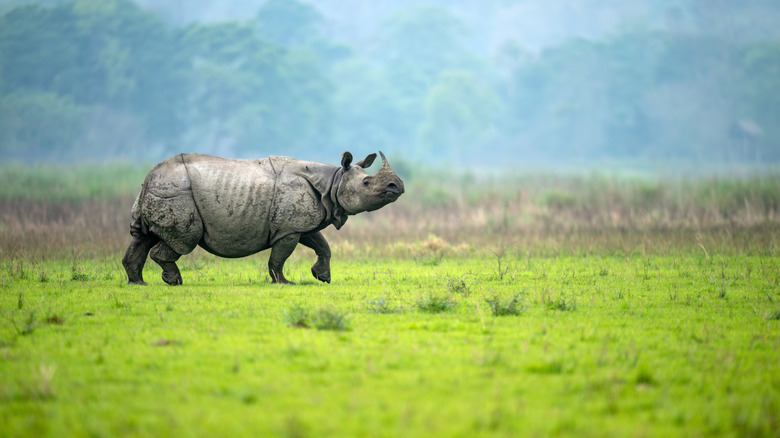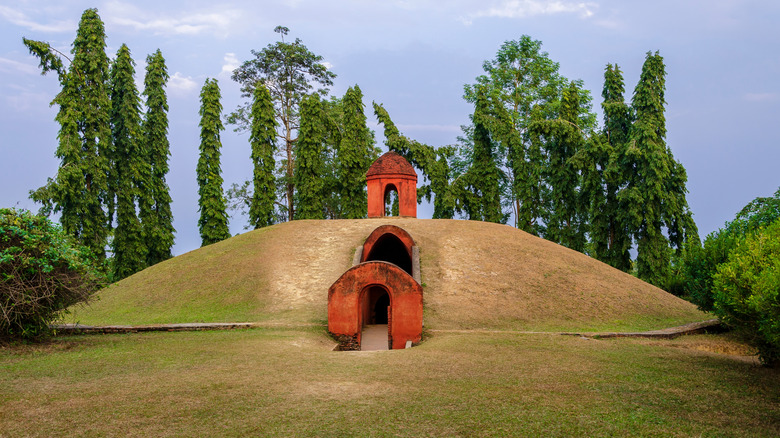India's Untouristed Mountain Region Brims With Ancient Pyramids, Wildlife Parks, And Gracious Tea Gardens
Away from the uber-romantic lakes, palaces, and markets of Udaipur, the buzzing megalopolis of Mumbai, and the white-sand beaches of the Andaman and Nicobar Islands is a whole other side to India. It's tucked into the far northeastern corner of the vast country, with the mighty Himalaya rising to the north, the riverways of Bangladesh opening into the Bay of Bengal to the south and west, and the wilds of Myanmar to the east. If that sounds like somewhere bursting with adventure and mystery, then that's because it is. Assam beckons with historical wonders, elephant-stalked national parks, and prestigious tea growing areas.
This whole region remains off the beaten path. According to official stats from the India Ministry of Tourism, the state of Assam received a small percentage of the footfall seen in the pocket-sized paradise of Goa in 2022, and even less of the international tourism counted in the legendary desert state of Rajasthan — though Assam is slowly entering the limelight. Other numbers reveal that Assam's mix of enthralling temples and wild nature reserves has helped put it in the top five fastest growing destinations in the country in recent years.
The good news is that Assam is perhaps the easiest place to reach in northeastern India. You can fly directly to Guwahati Airport, where a new terminal project is aimed at expanding capacity to over 13 million passengers annually. Alternatively, go the old-school way and arrive by train. There are regular long-distance links to the state capital from Chennai, Calcutta, Delhi — the list goes on. Just don't expect a short ride!
Pyramids and temples showcase the rich culture of Assam
Assam's location at the meeting point of Southeast Asia, China, and the Indian subcontinent has given it a rich cultural makeup. Empires and great dynasties have risen and fallen here over the millennia, leaving a string of eye-catching historical monuments and religious buildings in their wake.
Take the fabled Pyramids of Assam. Strung under the rising mountains deep in eastern Assam, they're one of the most striking remnants of the Ahom Dynasty who ruled this region for close to 600 years. Like the Egyptian pyramids before them, they're thought to be royal burial sites, but these pyramids differ from their African counterparts in that they're built directly into the landscape's hills, covered in sacred banyan trees and topped with elegant architectural gateways and staircases.
And it doesn't end there. The revered Kamakhya Temple draws in multitudes of pilgrims and culture-hungry sightseers each day. The temple sits on the edges of the Brahmaputra River in the state capital and is considered one of the spiritual centers of Tantric practice. You can come to see various worship rooms dedicated to the deities of the Hindu pantheon, or visit during the annual Ambubachi Mela festival to witness processions of robed sadhus gathering around the shrine.
Tea and untamed wilderness in Assam
For many people, the name Assam means just one thing: Tea. The first Indian commercial tea plantations were laid out here way back in 1839, and the region has since grown into the most prolific single tea growing state in India! Even if you're not a fan of morning brews, there's no denying that the plantations look spectacular. Head up to the Halmari Tea Estate, which has been rated among the most picturesque around, to walk through hundreds of hectares of lush green tea bushes, taste some artisan teas, and tour the leaf processing rooms.
Other corners of Assam are noticeably untamed. The Kaziranga National Park has earned itself a UNESCO tag for being one of the last vestiges of truly wild landscape in this part of the subcontinent. Jeep safaris can take you deep inside its riparian plains along the Brahmaputra River, where rhinos, elephants, and even the elusive Bengal tiger can potentially be spotted.
The Manas National Park, also dedicated by UNESCO, is further north, butting up to the foothills that line the border with Bhutan. Go there for safari adventures through jungled valleys that are said to host around 500 species of birdlife and more than 20 highly endangered animals. Just remember that the best time to visit Assam for outdoors adventure is the dry season, which typically runs from November to May each year.


